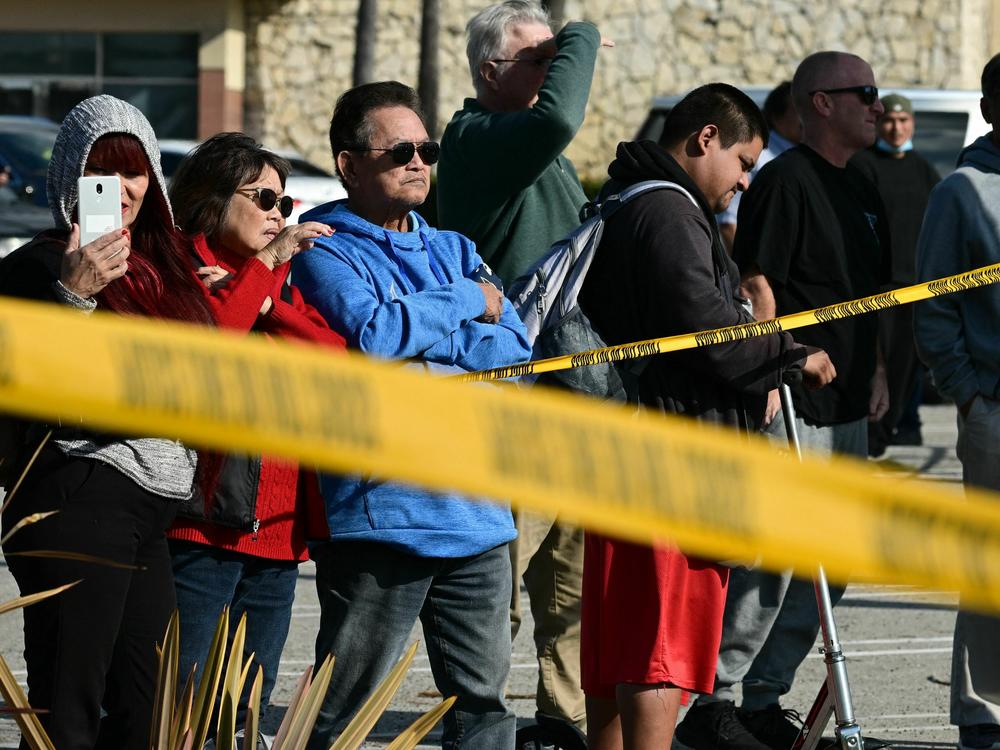Section Branding
Header Content
The suspected Monterey Park attacker was 72. Here's why older shooters are rare
Primary Content
Police are still investigating a motive behind an attack in Monterey Park, Calif., this weekend that left 11 dead.
The suspected shooter, a man named Huu Can Tran, was found dead with a self-inflicted gunshot wound after a manhunt on Sunday, authorities said.
He used a magazine-fed, assault-style pistol to complete the attack. Authorities believed he was acting alone.
But one detail may jump out to those familiar with stories about mass shootings: Tran was 72 years old.
Most mass shooters are young
Identifying the average age of mass shooters in the U.S. is tricky given there's no set definition of what a "mass shooting" entails and trackers vary in how far back their data reaches. But no matter which measure you look at, the age of shooters tends to skew lower.
The RAND corporation, a government-funded think tank, says that between 1976 and 2018, 82% of all mass shooters in the U.S. were under the age of 45.
The Violence Project, a nonpartisan, nonprofit research center, puts the median age of mass shooters at 32.
But Jillian Peterson, one of the project's co-founders, says there are really two distinct age clusters grouped around location.
"You see one cluster that's young, often school shooters, aged 18 to 25," she told NPR. "And then you see this second cluster in their mid-40s" who tend to open fire in workplaces, retail stores or restaurants.
Older mass shooters are outliers, but they're not unheard of
According to the Violence Project, the Monterey Park shooter is two years older than the previous oldest person to commit their definition of a mass shooting (to shoot and kill four or more people in a public space).
That shooting happened at a Kentucky retail store in 1981.
In 2021, a 57-year-old man killed nine people at a rail yard in San Jose, Calif. The gunman behind the 2017 attack on a Las Vegas music festival was 64.
Cynthia Miller-Idriss, a director of the Polarization and Extremism Research & Innovation Lab, pointed out on Twitter that in the last three years, high-profile acts of violence have visibly involved older perpetrators.
Take, for instance, the "very gray hair" noticeable among the crowds at the Jan. 6 attack on the U.S. Capitol, she says.
"Gender, age are not the protective factors people assume them to be," she added.
Young men are more likely to be impulsive
If not necessarily a protective factor, gender is, statistically speaking, a more predictable indicator of who's prone to gun violence. By the Violence Project's count, roughly 98% of all mass shooters are male.
Experts say the disparity is a result of biology and socialized masculinity. Gun ads are more likely to target men then women. Men are more often taught to externalize their feelings, looking for others to blame.
"Men in a younger age range are more likely to get in fights, more likely to be impulsive ... they haven't had full brain development," said Jonathan Metzl, a professor of psychiatry at Vanderbilt University.
And then there's the snowballing effect of copycat shootings, which young men, especially, are becoming more susceptible to.
"We've interviewed perpetrators and they literally say, 'I saw myself in previous perpetrators. I identified with them,' " said Peterson of the Violence Project.
"And before, if you wanted to find other people to celebrate mass shootings with, that was pretty difficult. But now, you can find entire online communities," she added.
Laws allow 18-year-olds to buy rifles and shotguns
Metzl says that neither gender nor age, at the end of the day, is the most important predictor for gun violence.
"It's access," he said. "The easier it is for people to get guns, the easier it is for people of all age demographics to get into shootings."
Under federal law, a person only has to be 18 to purchase a shotgun or rifle in the U.S., though some states have raised the limit to 21. There's currently no federal law preventing children from receiving so-called "long guns" as gifts.
And while the data is clear, Metzl worries that anomalous stories like the one forming around Monterey Park might distract from the overall toll of gun violence.
After all, despite the familiar patterns, victims of mass shootings make up a small percentage of gun deaths in the U.S. Of the 45,222 people the Centers for Disease Control and Prevention reported as dying from gun-related injuries in 2020, 513 people were killed in mass shootings, according to a tally by the Gun Violence Archive.
Copyright 2023 NPR. To see more, visit https://www.npr.org.



